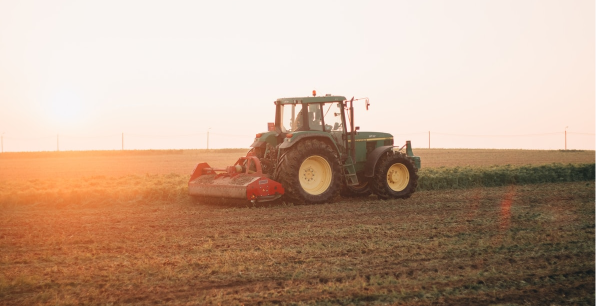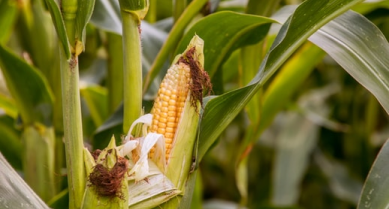Data-sharing pivotal to successful Food System
Agrimetrics’s response to DEFRA’s call for evidence for the National Food Strategy
On 27 June, Defra’s Secretary of State commissioned Henry Dimbleby to conduct an independent review to help the government create its first National Food Strategy for 75 years. This is Agrimetrics’s response.
Our food system is at risk of systemic failure. Small and ‘unrelated’ aggravations can be compounded through non-linearities and feedback loops to damaging effect. For example, 70% of the variation in global maize prices can be explained by heat variation in North America. Reactions from State and corporate actors can intensify these variations. Nations with the least resilience will feel the effects most acutely; the poorest citizens within those countries will suffer the most. The oft-cited ‘butterfly effect’ is well and truly alive in our agrifood system.
In many ways, the biggest risk to our food system stems from its complexity: many of today’s challenges are the consequence of managing an interconnected ecosystem in silos. Solutions can be uncovered by understanding that complexity through connectivity. Unfortunately, connectivity remains some way off.
The UK is a world leader in agri-tech – a market set to quadruple by 2025 – and the sector is capturing an unparalleled amount of data. These are essential building blocks for the evolution to data-driven decision making, which is revolutionising other sectors with impressive results: sectors employing such processes report that they are 5% more productive and 6% more profitable, with 40% lower maintenance costs and 50% lower development costs.
Improving the flow of data is critical. Data supply chains must run seamlessly alongside produce supply chains. This will uncover opportunities for improving productivities, efficiencies and environmental sustainability
However, realising these benefits will require additional blocks. Improving the flow of data within the food system is critical. Data supply chains must run seamlessly alongside produce supply chains. This will enable organisations to identify opportunities for improving productivity and efficiencies or points where environmental impact can be reduced. It will also encourage investment in the food system, by providing investors with greater clarity, vision and intelligence, and this investment will, in turn, stimulate innovation. To achieve this, however, stakeholders from the wider value chain must have access to those data too.
Researchers and commercial organisations are using data to improve traceability and consumer choice, animal welfare and environmental stewardship. For example, Agrimetrics has created models that optimise pesticide applications and create supply chain efficiencies. These improvements are being achieved with a fraction of the required data. As more data becomes more readily available, the effectiveness of existing solutions will be improved, and it will be possible to address more complex questions. The potential is revolutionary; unfortunately, significant barriers remain.
An outline of the climate concerning data sharing and recommendations for improvement can be read in a whitepaper, based on a report led by Agrimetrics for the Food and Drink Sector Council’s Agricultural Productivity Working Group. Broadly speaking, barriers can be understood in the context of cultural, political and structural dimensions. A suspicion of the motivations of industry and Government discourage some from sharing their data at all, those who are open-minded, but not convinced, are insufficiently incentivised, whereas, for those who are willing, there simply aren’t the technologies or processes to facilitate data-sharing fairly and securely.
Some of these issues require policy intervention, e.g. the introduction of incentives for data sharing and technology adoption. However, the introduction of a commercial market for data can overcome many of these hurdles.
A data marketplace – or data exchange – would enable data to be shared on a transactional basis, in return for insight, monetary payments or alternative incentives. Data owners would benefit from a more vibrant research space, new product development and recurring revenues. Data consumers would be able to access the data they need – this would transform the performance of models and applications.

For example, early-warning systems for pests and disease could optimise and reduce pesticide applications. Improved visibility of supply chains would drive down costs for industry and consumers by reducing waste, managing volatility and optimising logistics. Animal health can be improved. Consumers could view the provenance and sustainability footprint of their food on demand – enabling them to make informed decisions. Unilever estimates that the market for these kinds of insights exceeds $1tn.
This needs careful management. There is a risk that power becomes concentrated in the hands of a small number of commercial organisations. That consumers lose trust in an industry perceived as being inaccessibly hi-tech. And that sections of the supply chain are treated at best unfairly, and at worst exploitatively. A collaboration of academia, industry and Government – such as Agrimetrics – may be the best vehicle to realise these benefits whilst managing that risk. Independent information security standards – such as ISO27001 – can add legitimacy.
The formation of a Data Trust – defined by the Open Data Institute (ODI) as a legal structure that provides independent stewardship of data – may be the best way forward. This would overcome structural barriers to data-sharing, such as industry power dynamics and data being viewed as commercially sensitive. Interestingly, a 2019 report by the ODI describes an unsuccessful attempt to form a Data Trust to tackle the issue of food waste, launched in partnership with The Water and Resources Action Programme (WRAP). This experience revealed both the dire need to improve the flow and use of data in order to reduce food waste, and the significant barriers preventing this.
If we are to achieve the transformation of the food system that society needs, data sharing must be at the heart of any strategy.
About Agrimetrics
Agrimetrics is one of four agri-tech centres at the heart of the UK Government’s Agricultural Technologies strategy. Our mission is to catalyse innovation in the sector through the use of big data and advanced analytics. We do this by providing easy and affordable access to data, a platform for sharing and connecting complex data, and our own data science and AI expertise.
About the four centres
The Agri-Tech Centres are a unique collaboration between Government, academia and industry to drive greater efficiency, resilience and wealth across the agrifood sector. A £90m investment from the UK’s strategic innovation agency (Innovate UK) is enabling the Centres to harness leading UK research and expertise as well as build new infrastructures and innovation.
Other articles that might interest you

AI identifies crops from space with 90% accuracy
Agrimetrics launches CropLens AI, a proprietary algorithm that identifies crop types from space.

ClearSky: Cloud free satellite data for agriculture
ClearSky's artificial intelligence removes a major barrier to the efficacy of satellite

ClearSky: Cloud free satellite data for agriculture
ClearSky's artificial intelligence removes a major barrier to the efficacy of satellite

Agrimetrics partners with Airbus to reduce cost
Crop Analytics, a crop and field analytics package from Airbus, is now available at a new, lower price.



